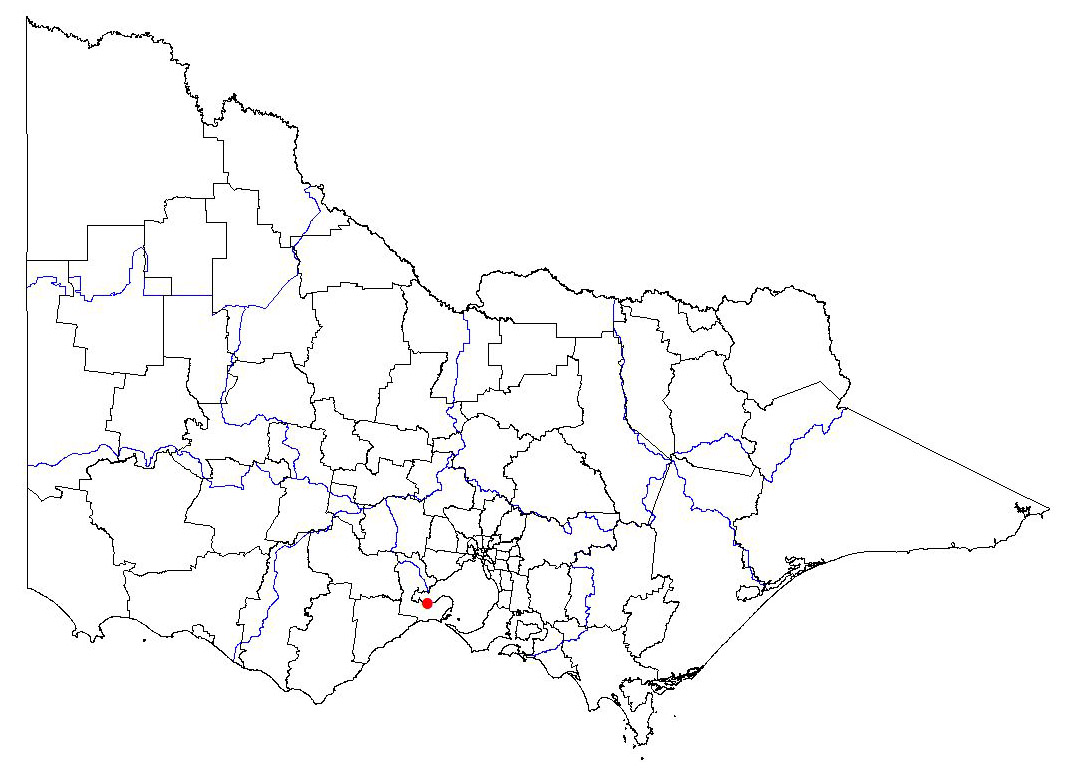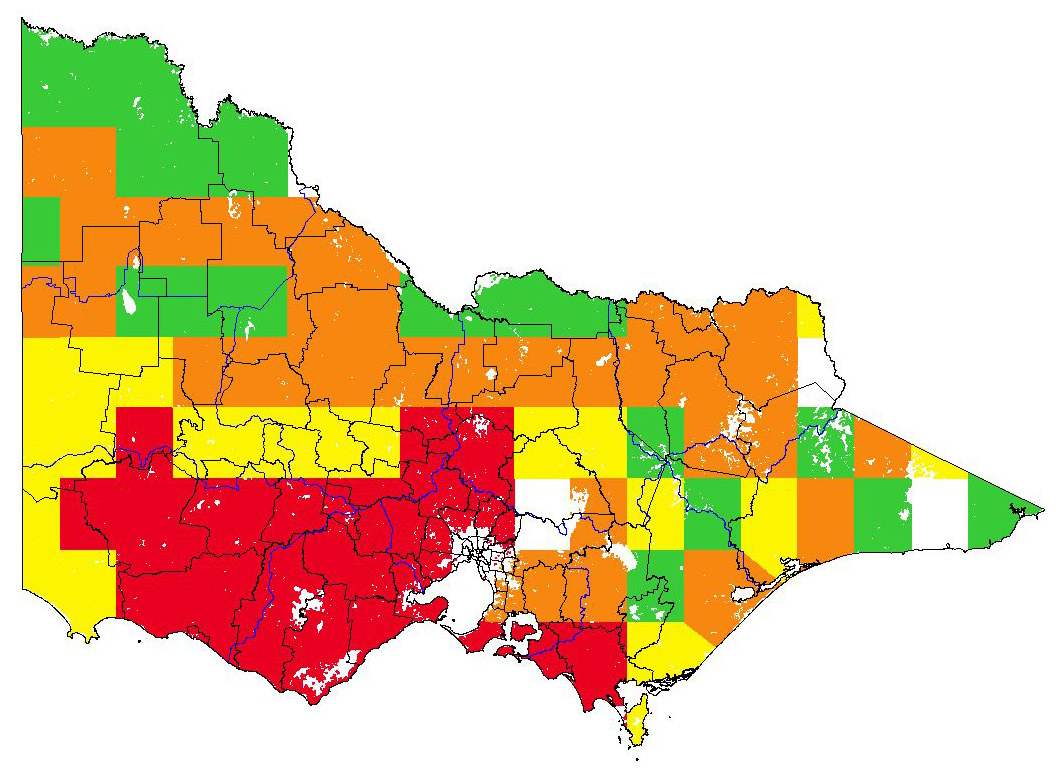Diplotaxis (Diplotaxis viminea)
Present distribution
|  Map showing the present distribution of this weed. | ||||
| Habitat: “Distribution in Israel: The Mediterranean Woodlands and Shrublands, Semi-steppe shrublands, Deserts and Extreme deserts” (FOIO 2003-2006). “They are weeds of disturbed sites” (Richardson et al. 2006). “Native in the Mediterranean region… Small annual 10-30 cm high” (Clapham 1952). Found in swards. Description: “Closed, dry perennial grasslands of eutrophic soils within the meso- and thermo-Mediterranean zones of the western Mediterranean basin, often on post-cultural land, formed by relatively tall grasses” (TEEA undated). “Native of vineyards, cultivated, and sandy places” (Don 1838). | |||||
Potential distribution
Potential distribution produced from CLIMATE modelling refined by applying suitable landuse and vegetation type overlays with CMA boundaries
| Map Overlays Used Land Use: Broadacre cropping; forestry; horticulture perennial; horticulture seasonal; pasture dryland; pasture irrigation Ecological Vegetation Divisions Heathland; grassy/heathy dry forest; lowland forest; foothills forest; forby forest; damp forest; granitic hillslopes; rocky outcrop shrubland; western plains woodland; alluvial plains grassland; semiarid woodland; alluvial plains woodland; ironbark/box; chenopod shrubland; chenopod mallee; hummock-grass mallee; lowan mallee; broombush whipstick Colours indicate possibility of Diplotaxis viminea infesting these areas. In the non-coloured areas the plant is unlikely to establish as the climate, soil or landuse is not presently suitable. | 
|
Impact
QUESTION | COMMENTS | RATING | CONFIDENCE |
| Social | |||
| 1. Restrict human access? | “Small annual 10-30cm high” (Clapham 1952). Minimal or negligible impact (ie. can go anywhere). | L | M |
| 2. Reduce tourism? | “Small annual 10-30cm high” (Clapham 1952). Weeds not obvious to the ‘average’ visitor. | L | M |
| 3. Injurious to people? | “Fruit (siliqua) has a short beak” (Richardson et al. 2006). Not described as toxic. (Covacevich et al. 1987; Everist 1974; Forsyth 1968; Shepherd 2004; Connor 1977; Cooper and Johnson 1984). Mildly toxic, may cause some physiological issues (e.g. hayfever, minor rashes, minor damage from spines and burrs at certain times of year). | ML | ML |
| 4. Damage to cultural sites? | Found in swards. Description: “Closed, dry perennial grasslands of eutrophic soils within the meso- and thermo-Mediterranean zones of the western Mediterranean basin, often on post-cultural land, formed by relatively tall grasses” (TEEA undated). Little or negligible effect on aesthetics or structure of site. | L | ML |
| Abiotic | |||
| 5. Impact flow? | “Distribution in Israel: The Mediterranean Woodlands and Shrublands, Semi-steppe shrublands, Deserts and Extreme deserts” (FOIO 2003-2006). “They are weeds of disturbed sites” (Richardson et al. 2006). “Native in the Mediterranean region” (Clapham 1952). Found in swards. Description: “Closed, dry perennial grasslands of eutrophic soils within the meso- and thermo-Mediterranean zones of the western Mediterranean basin, often on post-cultural land, formed by relatively tall grasses” (TEEA undated). Not described as aquatic. Little or negligible affect on water flow. | L | M |
| 6. Impact water quality? | “Distribution in Israel: The Mediterranean Woodlands and Shrublands, Semi-steppe shrublands, Deserts and Extreme deserts” (FOIO 2003-2006). “They are weeds of disturbed sites” (Richardson et al. 2006). “Native in the Mediterranean region” (Clapham 1952). Found in swards. Description: “Closed, dry perennial grasslands of eutrophic soils within the meso- and thermo-Mediterranean zones of the western Mediterranean basin, often on post-cultural land, formed by relatively tall grasses” (TEEA undated). Not described as aquatic. No noticeable effect on dissolved 02 or light levels. | L | M |
| 7. Increase soil erosion? | No information found. | M | L |
| 8. Reduce biomass? | “Small annual 10-30 cm high” (Clapham 1952). No information was found in relation to what vegetation this species was capable of replacing. More information needed. | M | L |
| 9. Change fire regime? | “Small annual 10-30 cm high” (Clapham 1952). Small or negligible effect on fire risk. | L | ML |
| Community Habitat | |||
| 10. Impact on composition (a) high value EVC | EVC = Plains Grassy Woodland (E); CMA = Glenelg Hopkins; Bioregion = Victorian Volcanic Plain; VH CLIMATE potential. Leaf arrangement rosette (FOIO 2003-2006). “Small annual 10-30 cm high” (Clapham 1952). Very little displacement of any indigenous spp. Sparse/ scattered infestations. | L | ML |
| (b) medium value EVC | EVC = Grassy Dry Forest (D); CMA = North Central; Bioregion = Central Victorian Uplands; VH CLIMATE potential. Leaf arrangement rosette (FOIO 2003-2006). “Small annual 10-30 cm high” (Clapham 1952). Very little displacement of any indigenous spp. Sparse/ scattered infestations. | L | ML |
| (c) low value EVC | EVC = Granitic Hills Woodland (LC); CMA = Goulburn Broken; Bioregion = Highlands – Northern Fall; VH CLIMATE potential. Leaf arrangement rosette (FOIO 2003-2006). “Small annual 10-30 cm high” (Clapham 1952). Very little displacement of any indigenous spp. Sparse/ scattered infestations. | L | ML |
| 11. Impact on structure? | Leaf arrangement rosette (FOIO 2003-2006). “Small annual 10-30 cm high” (Clapham 1952). Minor or negligible effect on <20% of the floral strata/layers present; usually only affecting one of the strata. | L | ML |
| 12. Effect on threatened flora? | No information found. | MH | L |
| Fauna | |||
| 13. Effect on threatened fauna? | No information found. | MH | L |
| 14. Effect on non-threatened fauna? | No information found. | M | L |
| 15. Benefits fauna? | “Small annual 10-30 cm high” (Clapham 1952). Not likely to be used as shelter, no information found to indicate use as food supply. More information needed. | M | L |
| 16. Injurious to fauna? | “Fruit (siliqua) has a short beak” (Richardson et al. 2006). Not described as toxic. (Covacevich et al. 1987; Everist 1974; Forsyth 1968; Shepherd 2004; Connor 1977; Cooper and Johnson 1984). No effect. | L | ML |
| Pest Animal | |||
| 17. Food source to pests? | No information found. | M | L |
| 18. Provides harbour? | “Small annual 10-30 cm high” (Clapham 1952). No harbour for pest species. | L | ML |
| Agriculture | |||
| 19. Impact yield? | No information found. | M | L |
| 20. Impact quality? | No information found. | M | L |
| 21. Affect land value? | No information found. | M | L |
| 22. Change land use? | No information found. | M | L |
| 23. Increase harvest costs? | No information found. | M | L |
| 24. Disease host/vector? | No information found. | M | L |
Invasive
QUESTION | COMMENTS | RATING | CONFIDENCE |
| Establishment | |||
| 1. Germination requirements? | No information found. | M | L |
| 2. Establishment requirements? | “Distribution in Israel: The Mediterranean Woodlands and Shrublands, Semi-steppe shrublands, Deserts and Extreme deserts” (FOIO 2003-2006). Can establish under moderate canopy/litter cover. | MH | M |
| 3. How much disturbance is required? | “Distribution in Israel: The Mediterranean Woodlands and Shrublands, Semi-steppe shrublands, Deserts and Extreme deserts” (FOIO 2003-2006). “Native in the Mediterranean region” (Clapham 1952). Found in swards. Description: “Closed, dry perennial grasslands of eutrophic soils within the meso- and thermo-Mediterranean zones of the western Mediterranean basin, often on post-cultural land, formed by relatively tall grasses” (TEEA undated). “They are weeds of disturbed sites” (Richardson et al. 2006). May establish in relatively intact or only minor disturbed natural ecosystems (eg. grasslands, open woodlands); in vigorously growing crops or in well-established pastures. | MH | ML |
| Growth/Competitive | |||
| 4. Life form? | “Diplotaxis species are erect herbs” (Richardson et al. 2006). Other. | L | MH |
| 5. Allelopathic properties? | No information found. (Rice 1984). | M | L |
| 6. Tolerates herb pressure? | No information found. | M | L |
| 7. Normal growth rate? | “Small annual 10-30 cm high” (Clapham 1952). Annual (FOIO 2003-2006). Moderately rapid growth that will equal competitive species of the same life form. | MH | M |
| 8. Stress tolerance to frost, drought, w/logg, sal. etc? | “Salt resistance: glycophyte...Distribution in Israel: The Mediterranean Woodlands and Shrublands, Semi-steppe shrublands, Deserts and Extreme deserts” (FOIO 2003-2006). “Native in the Mediterranean region” (Clapham 1952). Likely to be highly resistant to drought and tolerant to salinity. Not likely to tolerate frost or waterlogging. Unknown tolerance to fire. Tolerant to at least two and susceptible to at least one. | ML | ML |
| Reproduction | |||
| 9. Reproductive system | “Fruit (siliqua) has a short beak and seeds in two rows per chamber” (Richardson et al. 2006). “Flowers hermaphrodite only” (FOIO 2003-2006). May be sexual (self and cross pollination). | ML | ML |
| 10. Number of propagules produced? | “Seeds numerous” (Clapham et al. 1952). “Fruit (siliqua) has a short beak and seeds in two rows per chamber” (Richardson et al. 2006). For the purpose of this assessment, it is assumed ‘numerous’ means <2000. | H | ML |
| 11. Propagule longevity? | “Small annual 10-30 cm high” (Clapham 1952). Annual (FOIO 2003-2006). Greater than 25% of seeds survive 5 years, or vegetatively reproduces. | L | ML |
| 12. Reproductive period? | “Small annual 10-30 cm high” (Clapham 1952). Annual (FOIO 2003-2006). Mature plant produces viable propagules for only 1 year. | L | M |
| 13. Time to reproductive maturity? | “Small annual 10-30 cm high” (Clapham 1952). Annual (FOIO 2003-2006). Reaches maturity and produces viable propagules, or vegetative propagules become separate individuals, in under a year. | H | M |
| Dispersal | |||
| 14. Number of mechanisms? | No information found. | M | L |
| 15. How far do they disperse? | No information found. | M | L |
References
Clapham AR, Tutin TG and Warburg EF. (1952) Flora of the British Isles. Cambridge University Press.
Connor H.E. (1977) The Poisonous Plants in New Zealand. New Zealand Department of Scientific and Industrial Research, New Zealand. Government Printer, Wellington.
Cooper MR and Johnson AW. (1984) Poisonous Plants in Britain and their Effects on Animals and Man. Ministry of Agriculture, Fisheries and Food. Her Majesty’s Stationary Office, London.
Covacevich J, Davie P and Pearn J. (Ed's.) (1987) Toxic Plants and Animals: A Guide For Australia. Queensland Museum, Quorum Books, Brisbane.
Everist SL. (1974) Poisonous Plants of Australia. Angus & Robertson Publishers.
FOIO (Flora of Israel Online) (2003-2006) Diplotaxis viminea (L.) DC. The Hebrew University of Jerusalem. Available at:
http://flora.huji.ac.il/browse.asp?lang=en&action=specie&specie=DIPVIM (verified 01/04/2010).
Forsyth AA. (1968) British Poisonous Plants. Ministry of Agriculture, Fisheries and Food. Her Majesty’s Stationary Office, London.
Don G (1838) A General System of Gardening and Botany. Available at: http://books.google.com.au/books?pg=PP1&lpg=PA253&dq=Sisymbrium%20vimineum&sig=sV-5MLGPCytIsfCUhP4ACw38zNo&ei=rq7HS-37FMyIkAWXofyfCQ&ct=result&id=4MpAAAAAcAAJ&ots=0iieeyyCuN&output=text (verified 16/04/2010).
Rice EL. (1984) Allelopathy. 2nd Edition. Academic Press, Inc. Orlando.
Richardson FJ, Richardson RG and Shepherd RCH. (2006) Weeds of the South-east. An Identification Guide for Australia. RG & FJ Richardson. Meredith.
Shepherd RCH. (2004) Pretty But Poisonous. Plants Poisonous to People, An Illustrated Guide for Australia. RG & FJ Richardson. Meredith, Australia.
TEEA (The European Environment Agency, European Union) (undated) [Brachypodium phoenicoides] swards. Available at: http://eunis.eea.europa.eu/habitatsfactsheet.jsp?idHabitat=981 (verified 16/03/2010).
Global present distribution data references
Global Biodiversity Information Facility (GBIF) (2008) Global biodiversity information facility, Available at http://www.gbif.org/ (verified 16/03/2010).
Missouri Botanical Gardens (MBG) (2009) w3TROPICOS, Missouri Botanical Gardens Database, Available at http://mobot.mobot.org/W3T/Search/vast.html (verified 09/03/2010).
Royal Botanic Gardens Melbourne. (20) Census of Vascular Plants of Victoria. Available at http://www.rbg.vic.gov.au/research_and_conservation/plant_information/viclist (verified 16/03/2010).
United States Department of Agriculture. Agricultural Research Service, National Genetic Resources Program. Germplasm Resources Information Network - (GRIN) [Online Database]. Taxonomy Query. (2009) Available at http://www.ars-grin.gov/cgi-bin/npgs/html/taxgenform.pl (verified 16/03/2010).
Feedback
Do you have additional information about this plant that will improve the quality of the assessment?
If so, we would value your contribution. Click on the link to go to the feedback form.


